
mkt33
[PuristS]
5252

A 12 month review of Peter Speake-Marin's Piccadilly
Almost a nonexistent part of the horological landscape just a few years ago, the popularity of independent watchmakers is skyrocketing and so is the amount of money devoted to the purchase their unique timepieces. Three factors account for this amazing turnaround story. First the allure of knowing the craftsman and the provenance of a watch from construction to delivery is irresistible for many collectors. Second, independent watchmakers are immune from institutional and historical restrictions which may exist at larger watch manufactures. This freedom in creativity has allowed their custom timepieces to push the envelope in aesthetic as well as technical design. Most importantly the internet has created a virtual convention hall where enthusiasts can gather information efficiently and where independent watchmakers can promote their product effortlessly.
Despite the attraction of owning a bespoke timepiece, there can be pitfalls. Prestigious watch manufactures have earned their premium by providing the very best timepieces for tens if not hundreds of years. Maintenance services for these watches are easily accessible allowing them to remain family heirlooms for generations to come. Such history is not available for independent watch makers who often start out with very limited resources and rely on their customer’s faith and initial praise for success.
The purpose of this review of Peter Speake-Marin’s Piccadilly after twelve months of ownership is an attempt to build the legacy which is lacking in independent horology. I hope overtime, with input from other owners, a database of experience can be built which will allow enthusiasts to base their purchasing decisions on fact and not on initial hype, unfounded praise, or paid advertising.
Form
“Indeed, my aim is to increase the longevity of components as far as possible. The goal is not just to manufacture a product that sells well today. Its value will come from its durability over time. My objective is to make things that work well and for a long time. And finally, I aspire to make things that are beautiful. “-PSM[i]

White gold Piccadily
According to Peter Speake-Marin, the design of the cylindrical case was strongly inspired by the protoype movement holders he worked with while at Renaud & Papi. Measuring 38mm in diameter (without the crown) and weighing 135 grams, the Piccadilly has the wrist presence of a much larger watch because its thin bezel allows the dial to dominate the visual profile. The watch case itself is composed of two pieces, a relatively tall cylindrical body (13.5mm) and a slightly smaller bezel ring which is integrated but sits slightly above the body itself. Although the Piccadilly is just as thick as one of my larger Jaquet Droz, it wears taller because the side profile lacks contour. As a result I’ve found that the top “lip” is prone to inadvertent damage even though I’ve learned to be careful wearing larger watches.
The obvious focal points of the Piccadilly are its beautifully crafted dial and curvaceous blued hands whose tips end perfectly at the indices to allow for easy reading. I chose a rhodium plated and hand frosted white gold dial for my Piccadilly. The dial is multi-layered and it displays several different types of finishing on each tier; from the polished beveled edges on the nameplates to the brushed surfaces on the index ring. At the center of attention is a textured surface created by hand frosting. This technique involves carving grooves into the dial followed by the application of lacquer and gold dust to achieve the final effect. Considering that each layer of lacquer and gold is only microns thick and that each application must be dry before the next is applied, the depth of this textured surface indicates that the dial is extremely time consuming to create. According to Peter, a frosted dial takes artisans approximately three months to complete.
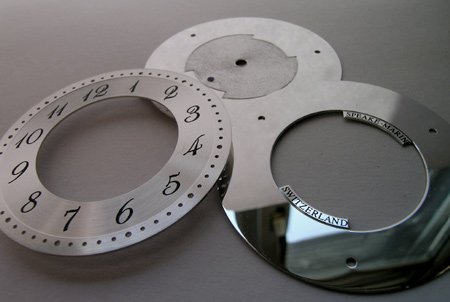
Multilayered dial prior to assembly
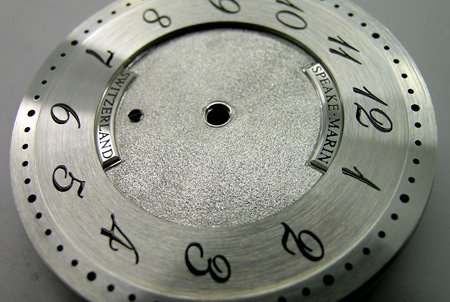
Frosted dial
The hands are completely made in Peter’s workshop and flamed blue in the traditional manner. They appear to be slightly curved or domed. The seconds hand with its ‘à pomme' tail is an easily overlooked detail. Finally two design elements (the painted Breguet numerals and the dial locating screw) is Peter Speake-Marin’s tribute to Abraham –Louis Breguet, considered by many to be the first watchmaker who paid attention to aesthetic watch design. It took me a few months to notice that the dial locating screw, the device found in between the center post and the 6’oclock index, is not flamed blue but actually violet. It resembles the color of the hands found on Peter’s first watch, the Foundation pocketwatch.
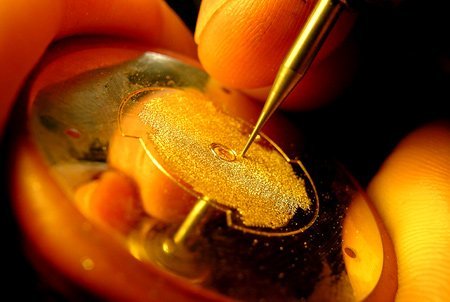
Hand frosting in action
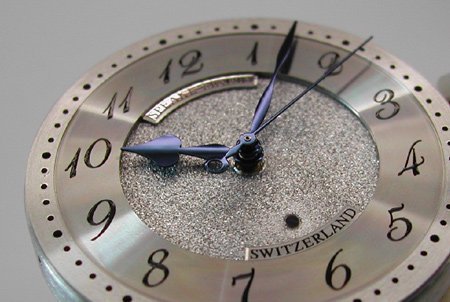
The caseback is snap fitted and engraved with the usual pertinent model information. Through its small sapphire window, a bespoke steel rotor inspired by a topping tool can be admired. Those who usually enjoy visualizing the decorative finish on watch movements and the swinging balance wheel will be disappointed.
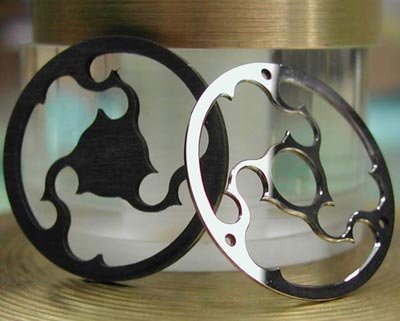
Bespoke rotor before and after polishing
The large Louis XV crown is a functional sculpture. The twenty five deep grooves carved into the crown allow for easy winding and add a touch of visual contrast against the otherwise polished surfaces of the case. Even though the crown extends out approximately 4mm, it never restricts the movement of my wrist nor presses uncomfortably against the back of my hand.

Louis XV crown
Perhaps the most controversial aesthetic component of the Piccadilly is the watch lug. I have to admit I was not a fan because at first glance the lugs appear to have an unsophisticated blockish form which seemed out of place with the rest of the Piccadilly design. Peter comments that the design of the lugs was never set in his mind and its final unconventional shape was the result of experimentation.
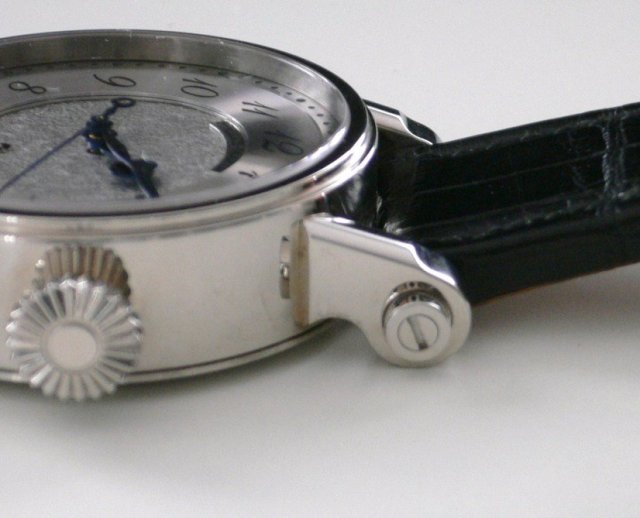
Powerfully designed lugs
A closer inspection reveals that the lugs must demand special attention when being milled and polished because every surface is curved except for their straight sides. When viewed laterally they resemble foundation columns supporting and holding up the watch case. After a year of ownership I would now argue that the lugs are the most important design component responsible for giving the Piccadilly its aura of gravitas, of permanence, and durability.
The theme of permanence and durability can be found in the smallest details; from the oversized crown tube, to the solid steel strap bars, to the tongue of the tang buckle which is two millimeters thick. Peter Speake-Marin’s focus on quality extends to even the strap itself. Made of stitched alligator hide on a leather backing, the strap is four millimeters thick and has minimal padding. Initially it was as stiff as wood and probably the most uncomfortable strap I’ve ever worn brand new. I have a bony prominence on my wrist and it actually hurt to wear the Piccadilly for the first two months, so much that I often hesitated putting it on. I stuck with the original strap because thinner and more comfortable aftermarket straps allowed the Piccadilly to turn on the wrist. In retrospect, however, it was well worth the pain. Now that the strap has been broken in, it is extremely comfortable and looks surprisingly new despite it age. At this rate I don’t think I will need to replace the strap for another few years. Interestingly the tang buckle it is made of stainless steel and not white gold as expected.
Overall I believe Peter Speake-Marin has effectively incorporated interesting design elements to form a neoconservative interpretation of classic English watchmaking. The Piccadilly evokes strong emotions from enthusiasts who have seen in person. Like it or not, it is the ability to draw these differing opinions which makes the Piccadilly a success now and in the years to come.
FUNCTION
“Many hours of work are then required to transform something that is simple into something exceptional. It is not a question of inserting precious stones or using special materials; it is the time spent on these watches that in my view gives them value”- PSM[ii]
The Piccadilly is powered by an extensively modified ETA 2824 which was renamed as the FW2012 after its transformation. According to Peter the ETA 2824 was chosen as the base movement because it is versatile, reliable, available, and it retains certain proportions of train design which are ideal and not often seen today. It also has a large balance to ensure precision time keeping.
The FW2012 starts out using the highest quality version of the ETA 2824 commercially available as its base. At Peter’s request it is customized with the longest available hour wheel, canon pinion and second wheel from his supplier. The movement arrives partially assembled at the Speake-Marin workshop where the alterations begin. First the automatic block is removed and replaced with a novel mechanism designed and manufactured by Peter Speake-Marin himself (as an example of the amount of work performed, the automatic bridge is completely re-milled out of German silver). Next, the motion work is modified to compensate for the extra thick Piccadilly dial and a bespoke steel rotor wheel is hand beveled and polished with a large 18K gold mass fitted underneath. Finally, for aesthetic purposes, all the steel components are hand refinished.
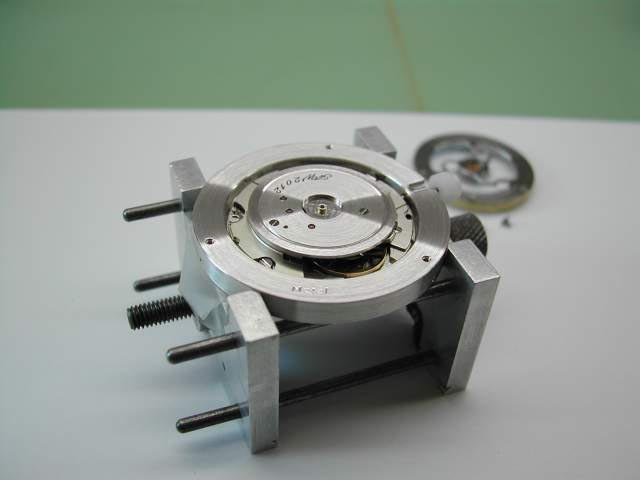
Movement in ring before casing- Note the bespoke rotor and weight in the background not yet assembled
When I performed my research before purchasing the Piccadilly, the fact that the FW2012 was derived from the ETA 2824 seemed to be a source of consternation for many enthusiasts. Some dismissed the Piccadilly as just another “recased” ETA model. Others claimed the Piccadilly had a new movement because the ETA was so heavily modified. As I am not a trained watchmaker, I cannot tear down my Piccadilly to argue these points from a technical perspective. However I decided to perform a few comparison tests between the FW2012 and a COSC certified ETA 2824 to see if there were any differences from a functional point of view. The comparison watch is from a well known manufacture which used the ETA movement without modifications except for added decorations on the rotor. The watch was purchased new from an authorized dealer about three years ago and has never been serviced.
Power Reserve:
The test was performed by manually winding both watches. The first noticeable difference between the two watches is that the Piccadilly’s second hand jumps immediately into action while the other remains at rest until enough energy has been stored in the mainspring. Fifty turns of the crown ensured that the mainsprings in both movements were completely wound and then the watches were left sitting flat with the dial up. The time it took for the mainspring to unwind was measured. This sequence was repeated three times and the results were averaged.
|
Comparison COSC ETA 2824 |
36.3 hours |
|
FW2012 |
39.5 hours |
Considering that the ETA 2824 has a specified power reserve of thirty eight hours, both samples fell within an acceptable 5% deviation.
Winding efficiency:
This test was performed with two different methods. First both watches were hand wound. The Piccadilly’s crown was turned for ten complete revolutions while the comparison watch was wound for twelve and a half revolutions to compensate for the difference in crown diameter. This test was repeated twice and results were averaged.
|
Comparison COSC ETA 2824 |
19.2 hours |
|
FW2012 |
21.6 hours |
The second method was to determine the winding efficiency of the two different automatic systems. I wore both watches on the same arm for three hours and measured the time elapsed until both stopped functioning again. This test was repeated twice and results were averaged.
|
Comparison COSC ETA 2824 |
9.0 hours |
|
FW2012 |
10.4 hours |
In my eyes, this aspect of the experiment was the most important as it highlights the main modification of the FW2012. PSM’s automatic system is 15% more efficient than a stock ETA 2824 based on my testing methods and sedate lifestyle.
The Piccadilly’s rotor is almost silent and it’s “wobble” is undetectable on the wrist. I presume this is an improvement brought about by Speake-Marin’s modifications to the automatic mechanism but since these two movements are cased in different materials (white gold versus stainless steel) I cannot verify this claim.
Accuracy:
The testing guideline from Peter Speake-Marin’s workshop is as follows:
“Each movement is tested first for precision of the time keeping over a two week period, starting before the automatic mechanism is placed on the movement and then continued after the automatic mechanism is mounted. Excluding the time spent in the manufacture of the new components I presently spend approximately fifty hours on each movement before it leaves the workshop. The timing required is a variation of less than 10 seconds in 5 positions with a gain from +1 to +6 seconds per day.”
When I purchased my Piccadilly the accompanying Control Sheet revealed its timing results (dated May 2005)
|
Before casing |
Average gain |
Positional variation in 5 positions |
|
Fully wound |
+5 sec |
(variation of 5 seconds) |
|
Minimum of 24 hours wound down |
+1 sec |
(variation of 8 seconds) |
|
After casing |
Average gain |
Positional variation in 5 positions |
|
8 hours on slow test simulator |
+ 5 sec |
(variation of 4 seconds) |
Although I do not fully understand the timing tests performed at Peter’s workshop, I’ve casually observed that the Piccadilly has kept great time over the last year. However I decided to check the accuracy again.
The Piccadilly was left in the proper position and the time was compared to the USNO (United States Naval Observatory) Master Clock time each morning. The Piccadilly was wound with ten complete revolutions of the crown each evening. The temperature was not controlled.
|
Day |
Daily rate (s/day) |
Variation of daily rates (s/day) |
Position |
|
1 |
+3 |
3 |
Vertical, 12 o’clock up |
|
2 |
0 |
|
|
|
3 |
0 |
2 |
Vertical, 3 o’clock up |
|
4 |
-2 |
|
|
|
5 |
+4 |
|
Vertical, 6 o’clock up |
|
6 |
+1 |
3 |
|
|
7 |
+2 |
|
Vertical, 9 o’clock up |
|
8 |
+1 |
1 |
|
|
9 |
+6 |
|
Horizontal, dial down |
|
10 |
+7 |
1 |
|
|
11 |
0 |
|
Horizontal, dial up |
|
12 |
+2 |
2 |
|
The average daily rate: +2 sec/day
Mean variation in rates: +2 sec/day
Greatest variation in rates: 3 sec/day
Difference between rates in horizontal and vertical positions: +1.5 sec/day
Largest variation in rates: 5 sec/day
Perhaps a bit out of the original testing specifications considering the positional variation between days 4-5 and 10-11 but overall a bit better performance (less variation of daily rates) than when the Piccadilly left the workshop over two years ago. I believe the FW2012, after timing regulation by Peter Speak-Marin, could easily achieve COSC certification if tested.
Conclusion
"A musician must make music, an artist must paint, a poet must write, if he is to be ultimately happy. What a man can be, he must be. This need we may call self actualization...It refers to the desire for self fulfillment, namely the tendency for him to becaome actualized in what he is potentially...the desire to become more and more what one is, to become everything that on is capable of becoming." - Maslow, 1943
This quote is Peter Speake Marin's inspiration as a watchmaker and the reason he started his own independent workshop. Although it is a simple time only watch, the Piccadilly is a solid representation of Peter Speake-Marin's talents. To build the Piccadilly's legacy, I will continue to repeat thses tests on an annual basis. However I suspect that my insights may not be valid until my son takes over this task since I firmly believe that the Piccadilly is so well constructed that it will outlive me.
[i] Peter Speake Marin Gives Time to Time, Le Journal De La Haute Horologerie, 8 issue, 2007
[ii] Peter Speake Marin Gives Time to Time, Le Journal De La Haute Horologerie, 8 issue, 2007
Pictures are by Peter Speake Marin. The copyright of photographs and text from Peter Speake-Marin is acknowledged and annotated. Other Article-specific Text and Photographs Copyright are assigned to PuristSPro.com , 2007. All rights reserved.
The author has not received any compensation from Peter Speake-Marin or any of his affiliated agents for this article.

A 12 month review of Peter Speake-Marin's Piccadilly

Peter's philosophy is admirable

Great review Michael. Had a fun time reading it!

This great review has so much substance

That's the purpose...I hope one day you can add your experience to the database as well

The frosty

More than meets the eye

Well done
There's a whole bunch of us there on Friday and Sat..



